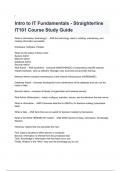/
Intro to IT Fundamentals - Straighterline
IT101 Course Study Guide
What is Information Technology? - ANS the technology used in creating, maintaining, and
making information accessible
(Hardware, Software, People)
What are the duties of these roles:
System Admin
Network Admin
Database Admin
Security Admin
Web Admin - ANS SysAdmin - oversees MAINTENANCE of computer(s) and/OR network.
Installs hardware, sets up software. Manages user accounts and provides training
Network Admin-oversees maintenance of the network infrastructure (HARDWARE)
Database Admin - oversees development and maintenance of the database and can use the
mass of data
Security Admin - oversees all facets of organization and network security
Web Admin (Webmaster) - install, configure, maintain, secure, and troubleshoot the web server
What is information - ANS Processed data that is USEFUL for decision-making (interpreted
data)
What is data - ANS facts that are not useful for decision making by themselves
What is the DIKW HIERARCHY model? - ANS DIKW stands for Data, Information, Knowledge,
Wisdom.
Hierarchy implies that one precedes the next;
First, Data is inputted to either person or computer.
Second, Information is inferred from the processed data
Third, Knowledge is information that has been put to use
Finally, Wisdom is the "Why"; why was the knowledge put to use
,What is an information system? - ANS Data input, processing, and information output. (a
system of producing information from data)
What is the difference between an information system and information technology? - ANS
Information technology is the technology infrastructure that SUPPORTS information systems.
IT is hardware, software, networks and databases that allow information systems to run and
data to be transformed into information
What is quality data/ The 5 Characteristics of Quality data? - ANS Data which is Relevant,
Timely, Thorough, Accurate and Reliable
What is the Information processing cylce? - ANS Input, processing, output, storage. (IPOS)
What is a computer system? - ANS combination of hardware components, peripheral devices,
software, users, and networks
What is the most commonly used network protocol? - ANS TCP/IP ( Transmission Control
Protocol/Internet Protocol)
What falls under computer Hardware? - ANS Physical components that are internal to the
computer such as Motherboard, CPU, Disk drives, Memory sticks or external to the computer
known as peripheral devices such as Keyboard, mouse or printers/ monitors.
What is the history of computer usage? Who, in what order in the last 75 years, used computers
first? - ANS First computer users were the engineers that built and programmed them.
Second users were specially trained employees of organizations that purchased the expensive
computers.
Third users were people purchasing personal computers.
Finally GUI operating systems were invented and ability to use a computer became common.
What are Protocols and why do we need them? - ANS Communication protocols are important
in telecommunications systems and other systems because they create consistency and
universality for the sending and receiving of messages
What is difference/purpose of between memory slots and expansion slots?
What are power connectors? - ANS Memory slots are strictly for adding RAM, expansion slots
are for a variety of optional hardware to expand use out of computer such as graphics card,
network card or audio card etc.
What are 4 main components of computer? - ANS CPU, Memory, I/O(Input/Output subsystem)
and Bus
, What is I/O subsystem? - ANS Input/ Output system of all peripheral devices such as mouse,
key board (input devices) or monitor and speakers (output devices)
What is the Bus/ what does it do? - ANS it is the device that permits information to move
between each component.
It is made of several wires, each of which allows 1 bit of current to flow over it
What are bits and bytes and words? - ANS a bit is a single unit of computing that is either a 0 or
a 1.
There are 8 bits in one byte.
A byte is the basic unit needed to code one character
A word is 32 or 64 bits
What is the system unit? - ANS Refers to the computer system, it consists of most of the
hardware a computer needs to run. Think the computer case and all its hardware inside
What are the Internal Components of the System Unit? - ANS the case, Slots (internal bays
that grip internal components), Buses, the circuitry that enable communication between internal
components, Bays (external openings for connecting peripheral devices)
What are Expansion slots? - ANS Connectors on a motherboard that enable users to add
optional components to a system such as graphic cards, network cards and sound cards
What is the ALU?
What is the CU? - ANS CPU consists of two parts:
ALU; Arithmetic Logic Unit - does the actual processing of the data
CU; Control Unit - retrieves instruction and raw data and coordinates the sending of instructions
to ALU
What is the measurement used to identify "Clock Speed" on today's computers? - ANS GHz
(Giga Hertz) remember building your own pc had a 4.2 GHz processing speed
What are the two types of RAM? - ANS Dynamic RAM (DRAM - main memory) and Static RAM
(SRAM - cache memory and registers)
What is ROM? - ANS Read-Only Memory, retains its memory indefinitely (is not short term, can
not be added or written to!)
What is BIOS ROM? What does it do? - ANS Basic Input-Output System Read Only Memory.
This software runs when the computer is first turned on to run tests on memory and CPU,
initializing hardware so that the primary operating system can boot up.
This type of storage is volatile - ANS RAM due to its short term/temporary storage before the
data is processed. Data or information stored in RAM dissapears when a computer is turned off.





